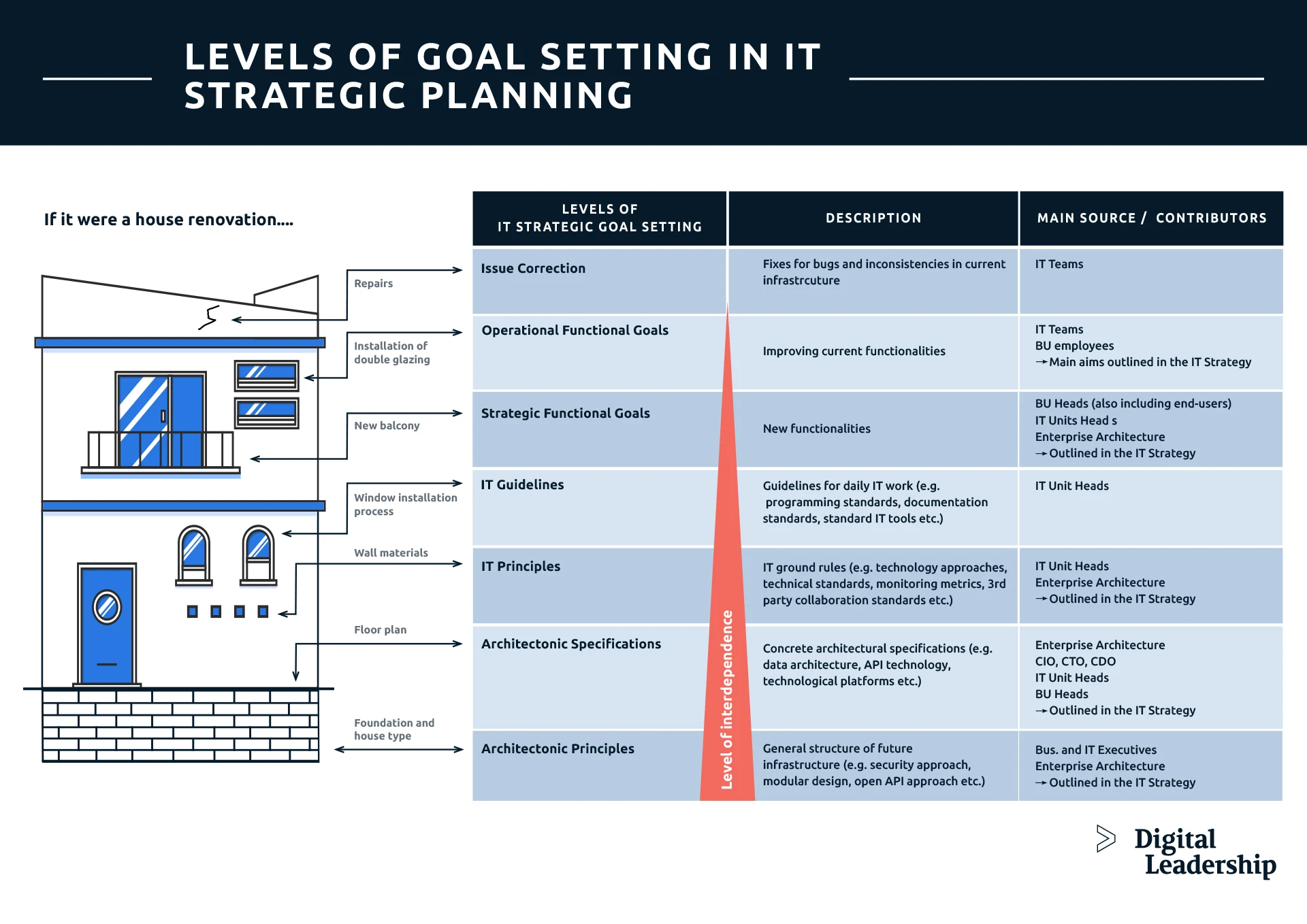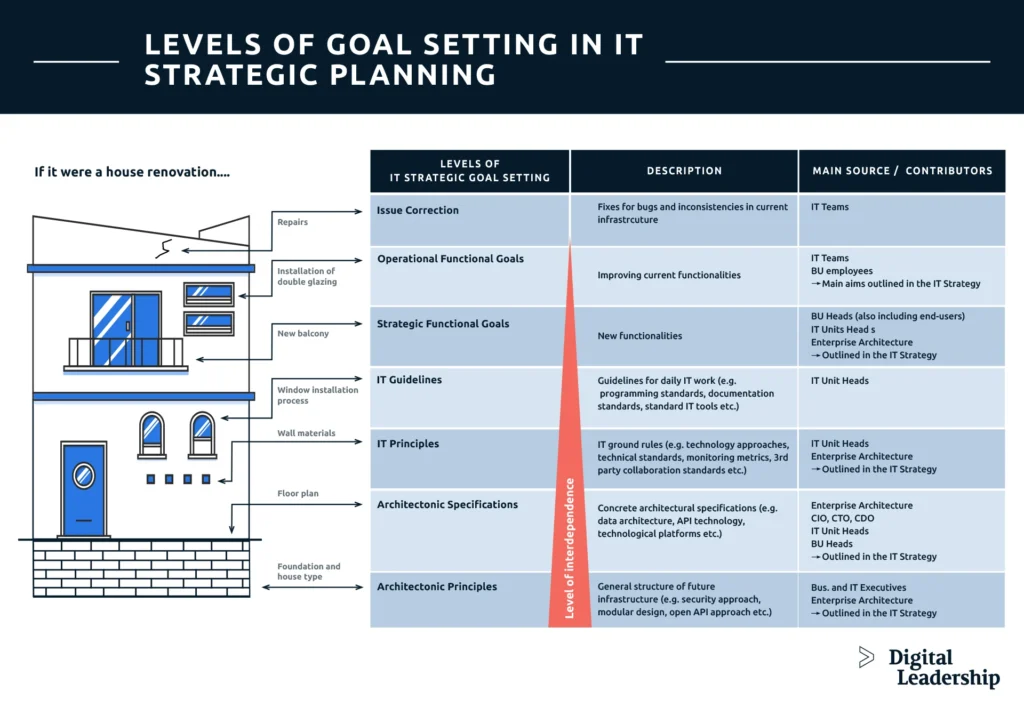Identify your IT Strategic Goals as basis for IT strategic planning
Published: 25 July, 2023
Technology & Engineering

Table of Contents
Introduction
A core element of IT strategic planning is the goal setting. This should already be included in the IT strategy – at least with regard to the requirements arising from the business strategy as well as the most important technological and architectural specifications. However, this input must be broken down into executable elements as part of the IT strategic planning.
In addition to the requirements of the IT strategy, there are smaller, more tactical elements that come to light during operations and should also be addressed.
And finally, many new questions will arise in the detailed elaboration of functional and technical demands, which in turn may lead to new requirements.
We describe the IT strategic planning process in the article “IT Strategic Planning Process”. Here we go into more depth on the topic of IT Strategic Goal Setting.
Gain a deeper understanding of the significance of Technology & strategic business goals through our book “How To Create Innovation.” This comprehensive resource explores the complexities of developing and implementing effective IT strategic plans, featuring essential concepts, best practices, and real-world case studies. Embark on a journey towards successful technology integration and business alignment, unlocking valuable insights from this book. Download now for transformative knowledge.
Importance of IT Strategic Goal Setting – Building the Future
IT Strategic Goal Setting has a very important role to play in today’s dynamic, technology-driven environment. The future of a company literally depends on it. With IT development cycles that can take months for simple functions, and sometimes 2-3 years for major transformations, the IT Strategic Goal Setting sets the framework for the company’s strategy development for years to come. At Digital Leadership, our IT Strategy consulting and Technology Strategy services go beyond acknowledging technology’s significance; we prioritize the value of well-designed IT Strategic Goals. Recognizing the pivotal role these goals play in successful digital transformation journeys, we align technology initiatives with overall business objectives and foster an innovative culture. Our approach empowers organizations to stay competitive, agile, and future-ready amidst the dynamic and competitive business landscape of today.
Not only will the infrastructure for future business models be built. Internal structures are created, know-how is built up on both the IT and business sides, new forms of cooperation with third-party providers are created and often new, more agile ways of working are introduced.
One should not forget that nowadays the IT strategy influences the business strategy just as much as vice versa. It is just that the development cycles of IT strategy require very forward-looking planning.
The IT Strategic Goal Setting seeks answers to many components that are key to the company’s development:
- Optimisation of existing processes, thereby reducing costs and the susceptibility to errors
- Building a scalable technological base on which the company can grow
- Implementing increasingly stringent security and compliance requirements
- Implementing new industry standards – whether technical, such as external interfaces, or customer-focused, such as registration processes
- Enabling the optimal use of third-party services in order to benefit from the best possible solutions in a digital ecosystem.
- Enabling rapid development cycles to respond efficiently and timely to future needs
- Enabling the use of the full potential of the data available to the company – this becomes all the more relevant in the context of the currently much-discussed AI systems
- And last but not least, the ability to respond to the increasingly confidently expressed customer desires – whether it is new communication channels, immediate response to enquiries or round-the-clock availability
Thus, the success of the technological transformation, and thus the long-term success of a company, stands or falls with a robust IT Strategic Goal Setting!
Characteristics of a good IT Strategic Goal Setting – Being S.M.A.R.T.
In IT strategy, goals are often described in quite general terms, with the aim of describing their effect on the development of the company. In IT strategic planning, on the other hand, it is a matter of defining implementable goals. These must therefore be more specific, and the implementation process must also be taken into account.
A good way to ensure this is to apply the S.M.A.R.T. approach to the IT strategic goals. This will also help to determine the most important indicators for prioritising them in the subsequent road mapping process.

Note that in this phase “T” for “Time-based” means the effort for implementation rather than its timing, as the latter is determined in the roadmapping process.
In addition, as always, all parties concerned should be involved. The strategy-defining parties – BoD, ExB incl. the CIO, CTO and CDO, should have already given their input during the creation of the IT strategy. The planning now requires cooperation between project or programme management, the business units, the IT Team Heads and the IT Teams.
Of course, it may be that new insights are gained during the IT Strategic Goal Setting that requires a revision of the IT strategy. In that case, the above-mentioned executives have to come back to the table!
Levels of IT Strategic Goal Setting – From Foundations to Functions
During a comprehensive IT transformation, the company is changed on many levels. The foundations are laid on which the infrastructure and functional developments are built, it is ensured that (new) company-wide principles, such as those relating to modularity or sustainability, are taken into account for the infrastructure, new functions are implemented and the development of new customer offerings is prepared, processes are optimised, errors are eliminated and the measurability of various indicators is made possible, which help with control and operations.
Some of these intentions are included in the IT strategy, many are only introduced during the IT strategic goal-setting process. And they must all build on each other, be consistent and realisable.
This is not a task to be underestimated, but one that takes time and must be carried out systematically – not least because subsequent adjustments can have an impact on many areas and require a great deal of additional effort. And in the worst case, insufficient planning can result in a patchwork of systems that can paralyse the long-term development of a company.

Challenges and Pitfalls in IT Strategic Goal Setting – You are not alone
The greatest danger in defining IT strategic goals comes from the insufficient involvement of key stakeholders. This can create a whole range of problems – from misunderstood business objectives, and consequent lack of stakeholder buy-in, to misjudgement of effort and unrealistic expectations. All this can quickly create a lot of tension within the company but also lead to the failure of the whole transformation project.
But there is a whole list of dangers beyond that, not all of which have to do with the goals themselves, but also with the way they are handled. Here are the most important ones:
- Lack of Clarity and Specificity: Vague or ambiguous goals can lead to confusion and misunderstandings. IT strategic goals should be well-defined, specific, and measurable to provide clear direction for the IT team and align their efforts with broader business objectives.
- Insufficient Understanding of Business Needs: When IT goals are not closely tied to the organization’s overall business needs and objectives, it can result in the misallocation of resources and ineffective IT initiatives. IT leaders must have a deep understanding of the company’s challenges, opportunities, and long-term vision to set relevant and impactful goals.
- Overlooking Input from Key Stakeholders: Not involving key stakeholders from various departments and levels of the organization can lead to goals that do not align with their needs and expectations. Collaborative input and buy-in from stakeholders ensure that IT strategies are well-rounded and supported across the organization.
- Ignoring Technological Realities: Setting goals without considering the existing technology landscape, budget constraints, and the organization’s technological capabilities can lead to unrealistic and unattainable targets.
- Neglecting Risk Assessment: Failure to conduct a thorough risk assessment can result in unforeseen challenges that may derail the achievement of IT goals. Identifying and addressing potential risks beforehand can improve preparedness and increase the chances of success.
- Setting Too Many Goals: Having an excessive number of IT goals can spread resources too thin and make it difficult to prioritize effectively. Focusing on a few critical goals ensures that resources are concentrated on achieving the most impactful outcomes.
- Lack of Flexibility and Adaptability: The IT landscape is constantly evolving, and rigid goal-setting frameworks can hinder the ability to adapt to emerging technologies or changing business conditions. Being flexible and open to adjustments is essential to stay responsive to dynamic environments.
- Inadequate Communication: If IT goals and strategies are not effectively communicated across the organization, there may be misunderstandings or a lack of support. Transparent and consistent communication ensures that everyone understands the IT priorities and their importance.
- Poorly Defined Metrics for Success: Without clear metrics and key performance indicators (KPIs) to measure progress, it becomes challenging to assess whether IT goals are being met. Establishing relevant metrics enables objective evaluation and facilitates data-driven decision-making.
- Failure to Celebrate Achievements: Not recognizing and celebrating milestones and successes along the way can demotivate the IT team. Acknowledging achievements boosts morale and reinforces a sense of purpose in pursuing larger strategic goals.
It is up to the project or programme management to ensure that these pitfalls are recognised and addressed.
Producing first results early – Do good and talk about it
Few things are as important for success as the motivation of those involved. There are few more effective ways to achieve this than to clearly demonstrate the benefits of transformation early on by delivering initial results to stakeholders.
Not only is everyone happy to see their area enjoying new functionality, but it also helps to gain patience for more complex, long-term projects. And it ensures closer collaboration throughout the transformation process.
As mentioned in the last chapter, these achievements should be well communicated and properly celebrated! A conversation over a glass of wine – or juice – can sometimes strengthen the bond between teams better than any form of corporate organisation.
Conclusion
In summary, a robust IT Strategic Goal Setting is critical for a successful technology transformation, and thus for the long-term success of an organisation.
All too often, for short-term, tactical, sometimes power-political or personal reasons, important components of it are omitted or postponed to a later time. This can and usually will have expensive consequences, and risks leading to the failure of the whole undertaking.
The process of IT Strategic Goal Setting is complex and time-consuming, but if done well, it forms the basis for a robust, consistent implementation roadmap that not only makes optimal use of IT resources but also provides the business with a clear development roadmap and transparent planning.
So I would recommend every company to plan enough time and the necessary resources for this important phase, and if not available internally, do not hesitate to use experienced, external support. These are investments that will more than pay for themselves over time.

































 Book How to Create Innovation
Book How to Create Innovation